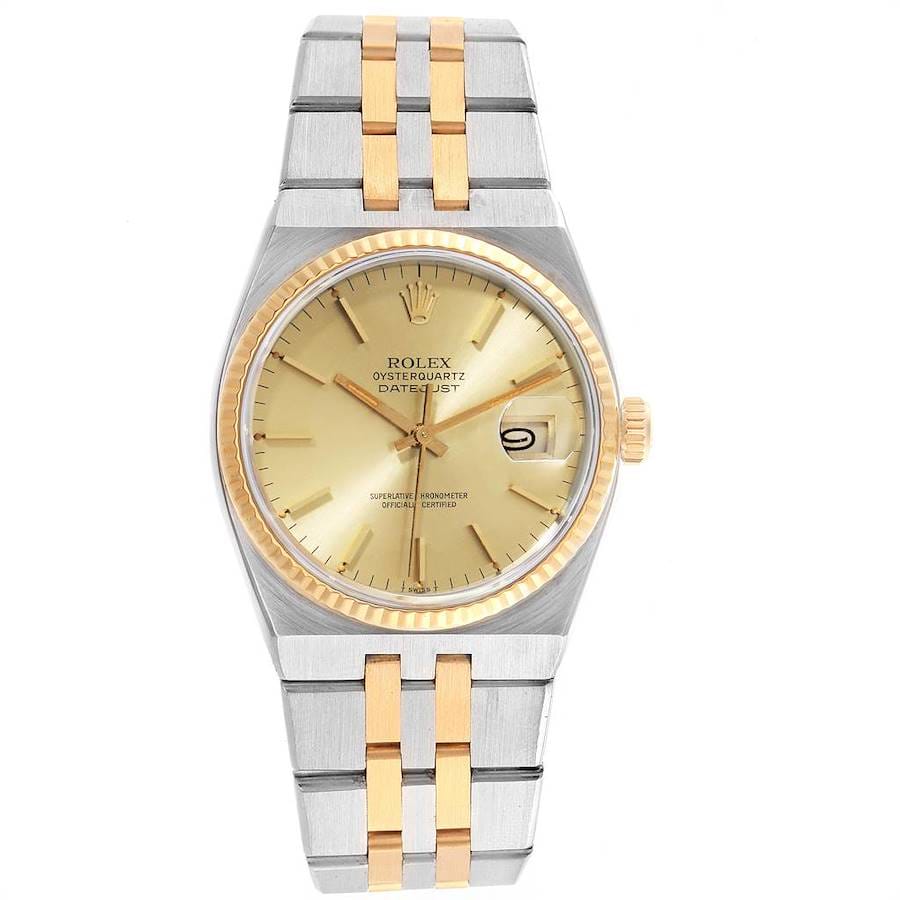Don't miss the next drop
Rolex Oysterquartz 17013
Last updated: July 22, 2025

Brand:
Model Line:
Production Period:
1977-2001
Caliber/s:
Case Width:
36mm
Case Height:
42mm
Lug Width:
20mm
Rolex Oysterquartz 17013 Description
The Rolex Oysterquartz Datejust ref. 17013 was produced from 1977 to 2001, representing Rolex’s bold, fully in‑house answer to the Quartz Crisis. Equipped with the thermocompensated Caliber 5035 quartz movement and encased in a uniquely angular 36 mm “cushion” case, the model was offered in two‑tone stainless steel and 18k yellow gold with an integrated Jubilee bracelet. Although only around 25,000 Oysterquartz models were produced overall, ref. 17013 remains relatively rare and has surged in popularity among collectors who appreciate its sharp 1970s design and quartz precision.
| Reference | 17013 |
| Production | 1977–2001 (catalog disappeared ~2003) |
| Case Diameter | 36 mm |
| Lug‑to‑Lug | ~42–42.5 mm |
| Case Thickness | ~12.5–13.5 mm |
| Lug Width | ~23.5–24 mm |
| Bracelet | Integrated Jubilee, tapering to ~16 mm |
| Movement | Rolex Cal. 5035 quartz, 32 kHz, 11 jewels |
| Accuracy | COSC‑certified, ±0.07 s/day |
| Power Reserve | Approx. 24 months battery life |
| Case Material | Stainless steel with 18k yellow gold bezel & crown |
| Crystal | Sapphire, with Cyclops date magnifier |
| Water Resistance | 100 m Oyster case |
Detailed Overview
The introduction of the Oysterquartz line marked Rolex’s resolute step into quartz technology during the upheaval caused by the Quartz Crisis. After earlier collaborations such as the Beta-21-based ref. 5100, Rolex shifted its strategy, culminating in five years of development and the debut of fully in‑house calibres 5035 and 5055 in 1977. Unlike many other quartz watches, the Caliber 5035 borrowed heavily from Rolex’s mechanical architecture—complete with gear train, pallet bridge, and mechanical escapement—augmented by thermocompensation and COSC certification for stellar ±0.07-second per day accuracy. With its 11 jewels and 32 kHz stepping motor, this movement remains one of the most advanced and serviceable quartz calibres Rolex has ever produced.
Rolex’s design for the Oysterquartz ref. 17013 embraced the bold stylistic trends of the 1970s with a sharply angular cushion-shaped case and integrated Jubilee bracelet reminiscent of contemporaneous sport-luxury icons. Measuring 36 mm across yet appearing larger due to its geometric profile, the watch features pronounced bevels, a striking integrated bracelet starting at about 24 mm and tapering to 16 mm, and a fluted 18k yellow gold bezel and two gold center links—hallmarks of its two-tone Rolesor construction. Thickness ranges from approximately 12.5 to 13.5 mm, giving it a robust wrist presence akin to modern sports watches.
While Rolex offered three Datejust Oysterquartz variants—the steel ref. 17000, the steel/white gold ref. 17014, and the steel/yellow gold ref. 17013—the 17013 introduced the full fluted bezel, matching crown, and integrated two-tone Jubilee bracelet in 1977. Dial choices typically include champagne, silver, white, black, and blue, most featuring baton indices, though later Roman numeral versions and luminescent hand upgrades from tritium to Luminova emerged in the late 1990s—marked by “Swiss” vs “T Swiss T” text variations.
Despite its advanced movement and aesthetic appeal, the Oysterquartz was a commercial oddity and produced in limited numbers—only around 25,000 across all Oysterquartz models in its 25-year run. Rolex ceased submitting quartz movements for COSC certification in 2001 and phased the watches out by 2003.
Historical & Cultural Significance
Rolex’s Oysterquartz stood as a rare blend of quartz precision and mechanical engineering excellence. It leveraged Rolex’s brand strength and mechanical-replica aesthetics to craft a watch that did not compromise on build quality, reliability, or brand DNA. The watch’s angular design stood out sharply from Rolex’s round-cased lineage, signaling Rolex’s innovative willingness to explore during turbulent times in horology .
Today, ref. 17013 enjoys a resurgence fueled by renewed interest in vintage integrated-bracelet watches, its relative rarity, and its robust accuracy. Its appeal spans both collectors seeking offbeat Rolex icons and connoisseurs of quartz craftsmanship. Prices in healthy condition generally range from $5,000 to $8,000—often fetching higher premiums for early Mark I dials, full box and papers, and unpolished examples . As of June 2025, listings typically trade within this band and often sell faster than 70% of the market, with median time-to-sale under three weeks.
Conclusion
The Rolex Oysterquartz ref. 17013 remains a compelling anomaly in Rolex’s storied catalog: a two-tone quartz watch engineered with mechanical rigor, coated in a bold 1970s aesthetic that remains striking today. Collectors prize it for its technological sophistication, design integrity, and scarcity. As vintage integrated-bracelet watches rise in esteem, the 17013 is well-positioned for continued appreciation, especially in exceptional condition or with rare dial variants.
As an eBay Partner, we may be compensated if you make a purchase.
